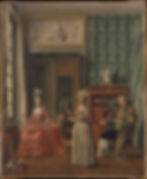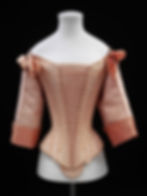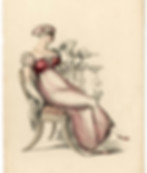Bodices, Busks, and Bustlines: The Corset’s Evolution from the 16th-18th centuries
First and foremost, I feel that it is my duty to inform you that the corset was not an anti-female torture device that the media has portrayed it as. In fact, the corset was quite the opposite. I also want to state that I am not going into extensive detail on specific decades; I am mainly going to talk about periods of dress in general.
The emergence of the corset is mostly unknown, but we can assume it emerged sometime during the 16th century. In the 15th century, clothing was molded to the wearer so that the dress would fit the body. In the 16th century, we see the emergence of a less natural silhouette with the stiffened bodices of the Tudor period which flattened the bust and rose above the breasts. We can infer that the women wearing these silhouettes either wore a stiffened undergarment to support the bodice of the garment, or wore a whole dress bodice that was stiffened individually for each gown or “kirtle”, which is a bodice attached to a skirt worn over a chemise and under an outer garment. Most likely to save time and money, a stiffened undergarment was worn. This is the beginning of the corset. I should also clarify that when I say, “bodice,” I mean just the part covering the bust and the back because Tudor gowns were assembled in parts, like a tiered wedding cake with base cake layers, fillings and frosting.

16th - 17th centuries
During the 16th-17th centuries, necklines changed somewhat drastically as did “pairs of bodies,” otherwise known as stays. In the Tudor period (1485-1603), women favored a wide, squarish neckline that flattened and pushed the bust down but, as time progressed during the Stuart period (1603-1714), necklines got progressively lower, and busts were pushed back up. Toward the middle of the 17th century in the Stuart period, off the shoulder low necklines came into fashion. As a result, we see a disappearance of straps, and more underbust support to push the breasts up to a fashionable level. Finally, towards the end of the 17th century, or the late Stuart period, we see necklines go back up onto the shoulders, but stay low cut, bringing back straps as seen in the earlier Tudor times. Interestingly, during the 17th century we also see evidence of some women wearing stays as outerwear, as well as underwear; there are some actual surviving examples of stays with detachable sleeves that were to be worn as an outer garment. This reflects a continuation from the Tudor to the Stuart period of individually stiffened bodices.
.png)
Princess Mary in regency dress

Queen Charlotte in court dress, mid-late 18th century
.png)
Lady in regency era
The stays of the Tudor and Stuart period flattened the bust and gave the wearer a conical-shaped torso, almost like a piece of pizza when viewed from the front. Stays in this period were most likely made of linen or silk that was starched and supported by a removable busk, which was a vertical piece in the front middle of the garment normally made of wood. They could also be supported by some boning around the sides of the garment made of reeds or whalebone and could be laced up either in the front or the back. Besides holding the bust and waist in a fashionable shape, the stays also helped support the heavy skirts of the gowns that women would wear, helping to prevent long term health issues such as back and shoulder problems.
Those Iron corsets
I felt I had to take a quick detour to tell everyone that the iron stays thought to have been used in the 16th century were not, in fact, widely worn during this time. These stays would have been widely unpleasant and impractical as it would have been too heavy; instead of supporting the bust and removing weight from hips, it would have just been really painful. So, dress historians have chalked up these iron corsets to either orthopedics prescribed by a doctor or the owner was simply eccentric.
18th century
During the 18th century (late Stuart, and early to mid Georgian period) we see a return to a more square neckline like in the 16th century. This Georgian period (1714-1830) look fluctuated a little, but it mostly was about a conical torso and a very low square neckline. In fact, necklines dipped so low that wardrobe malfunctions weren’t uncommon—”nip slips” were basically part of the look. During some points women would just walk with their breasts out almost completely. But even through that fun little point in 18th century dress, the stays of this period were largely the same. During the latter half of this 18th century Georgian period, though, we also see another informal type of stays called “jumps” emerge. Jumps were corsets without a busk and with less boning, or no boning and just cording; they had padding of cotton to support the breast, and were normally made of cotton or silk. They allowed a little more freedom of movement and were much more comfortable, making them a popular garment for the house and hard work, but were frowned upon to wear in public because they were too casual and slouchy, like wearing sweatpants to a graduation today.
So throughout the 18th century, we see the traditional conical-shaped stays being the main undergarment, but during the last decade or so of this century, a new type of stay comes into fashion, the short stays. The short stays were stays that did not extend past the bust in order to push the bosom up to create a shelf shape. Women also didn’t need to conform their waist to the garment because the garment fell way above their natural waist. The dresses that were fashionable during this time were largely influenced by the Greeks and Romans, so dresses were looser and had a column skirt which started just below the bust.
So we can see over the course of 200 years from the 16th to 18th centuries, stays were not there to hold women back—they were there to help women shape themselves to the fashion of the time, offering support, structure, and a surprising amount of practicality. It’s time we stop seeing them as symbols of constriction and oppression and start understanding them for what they really were.
Stay tuned for part 2!


.png)





